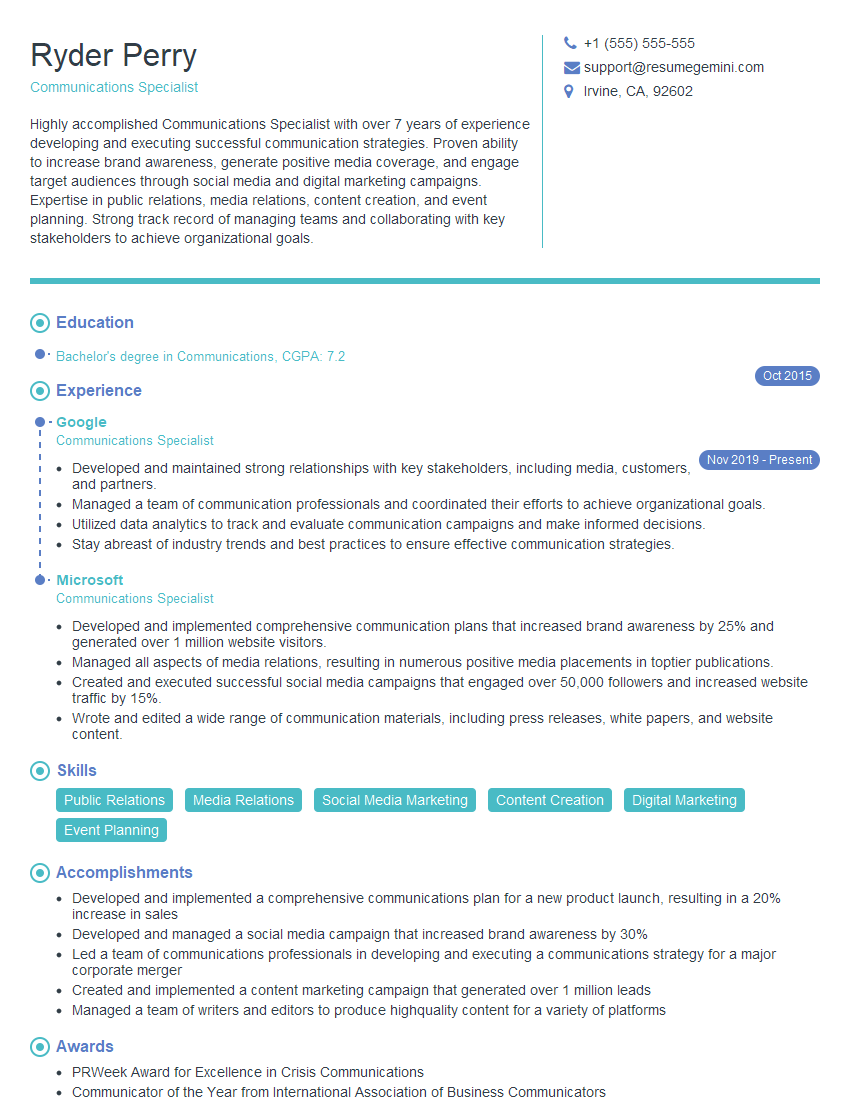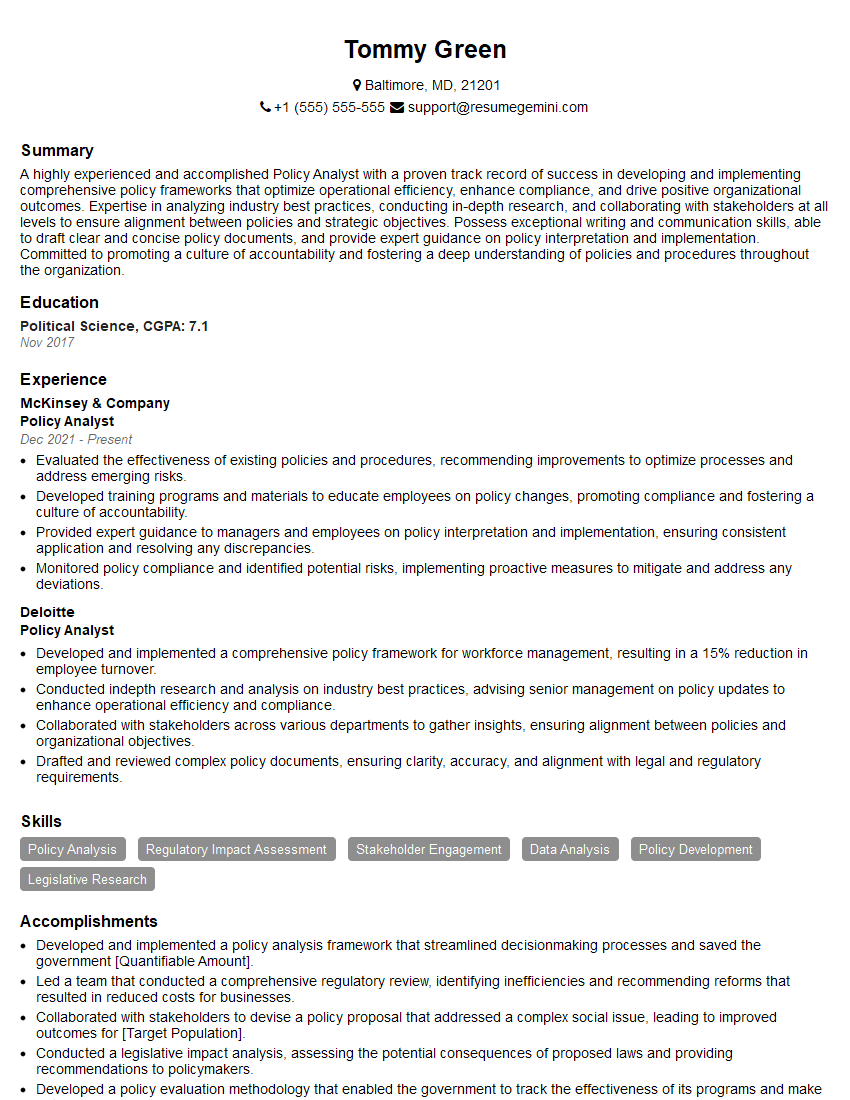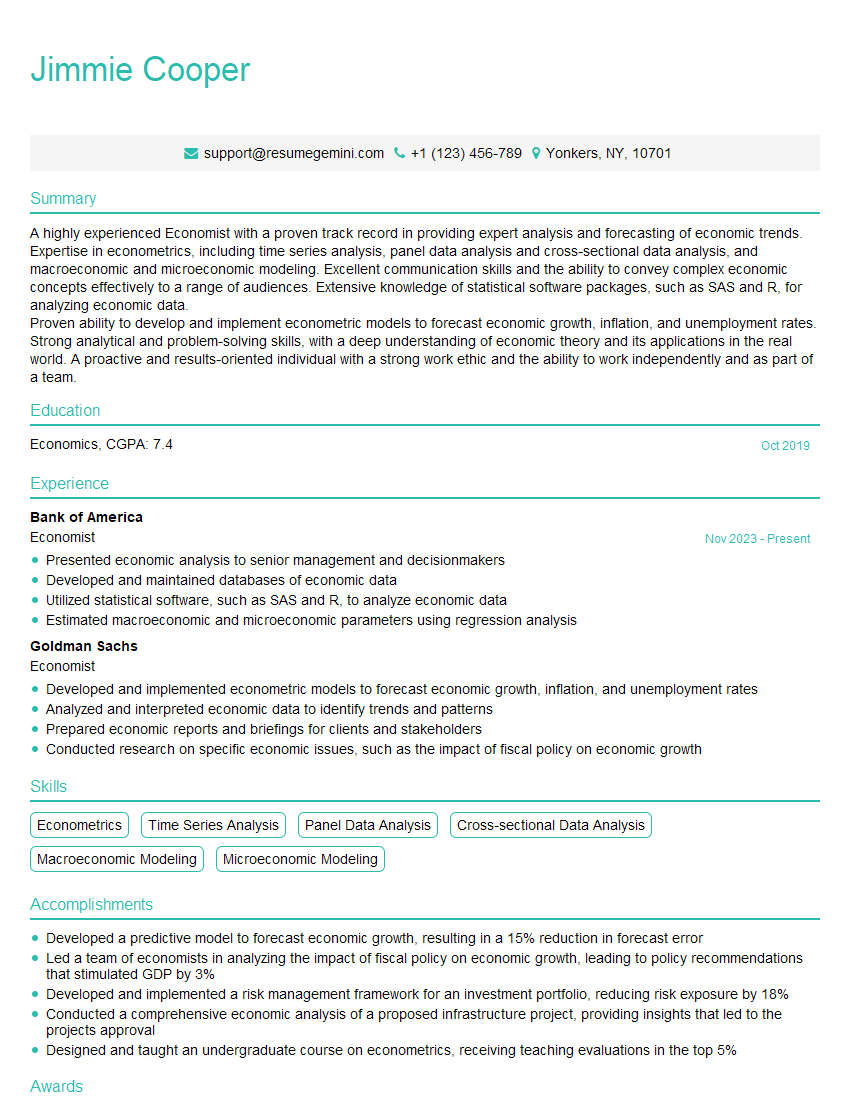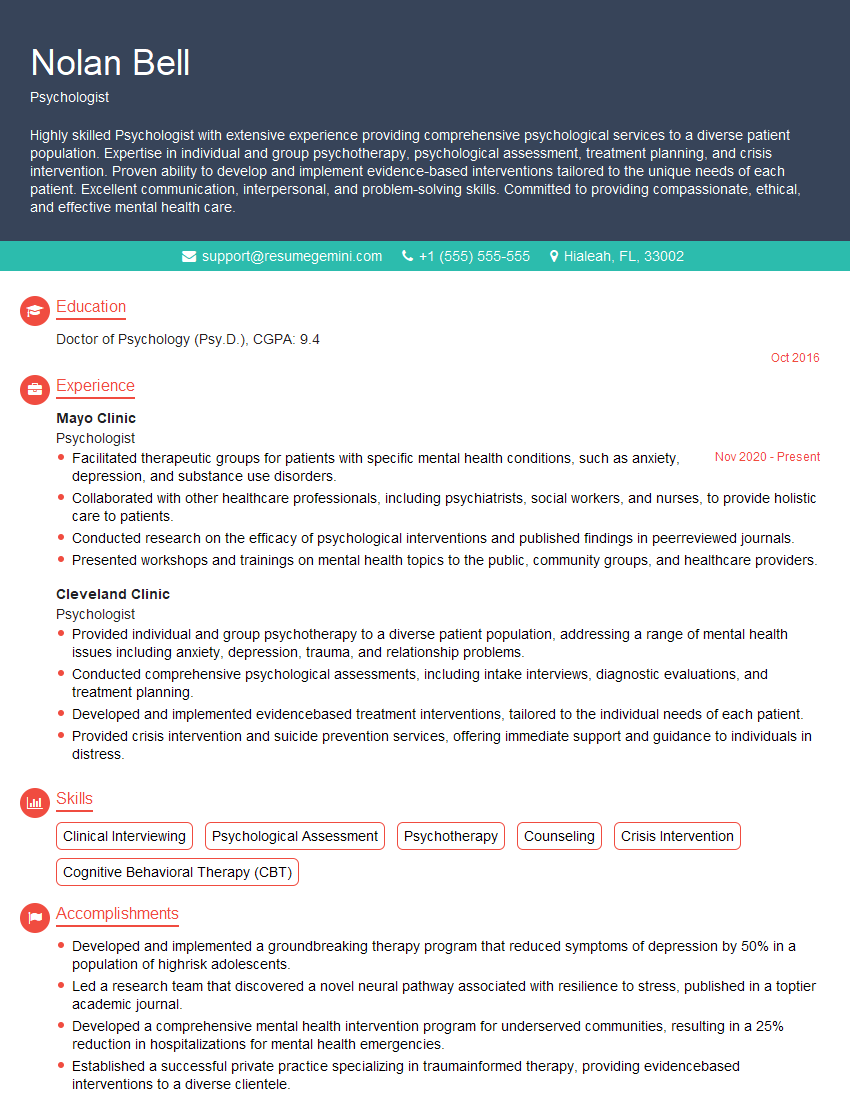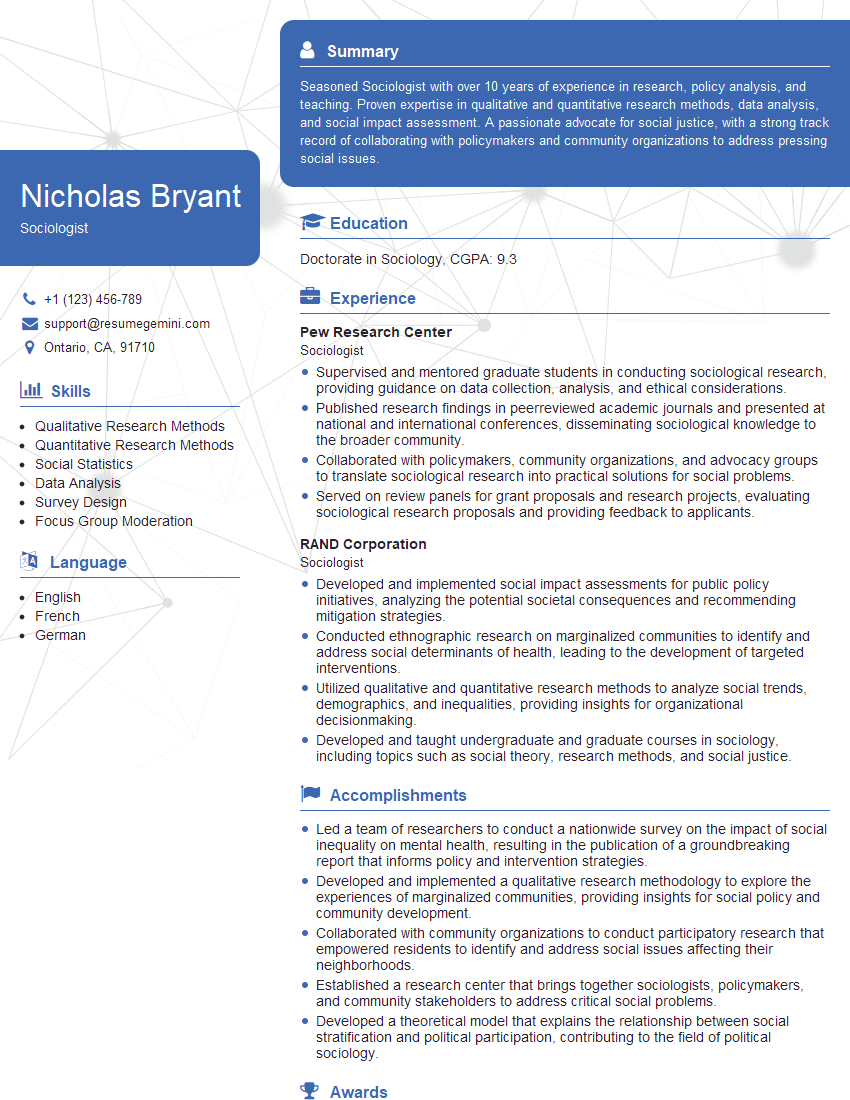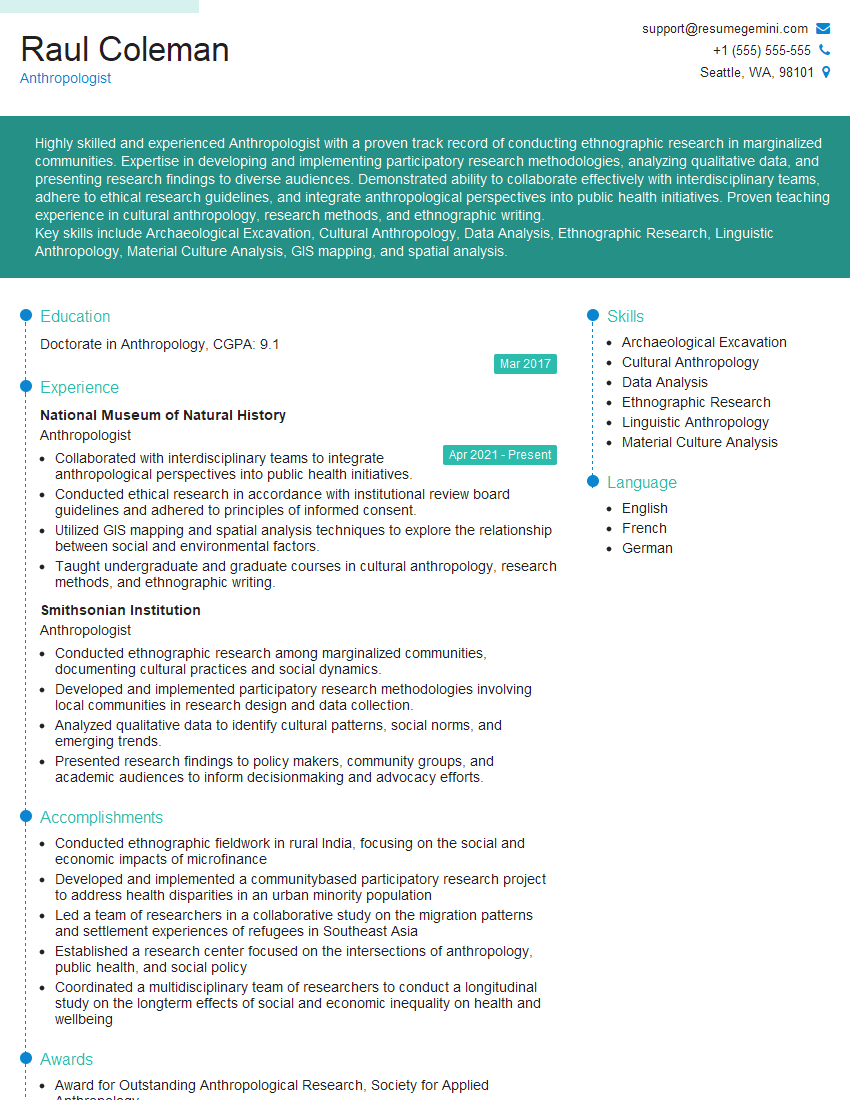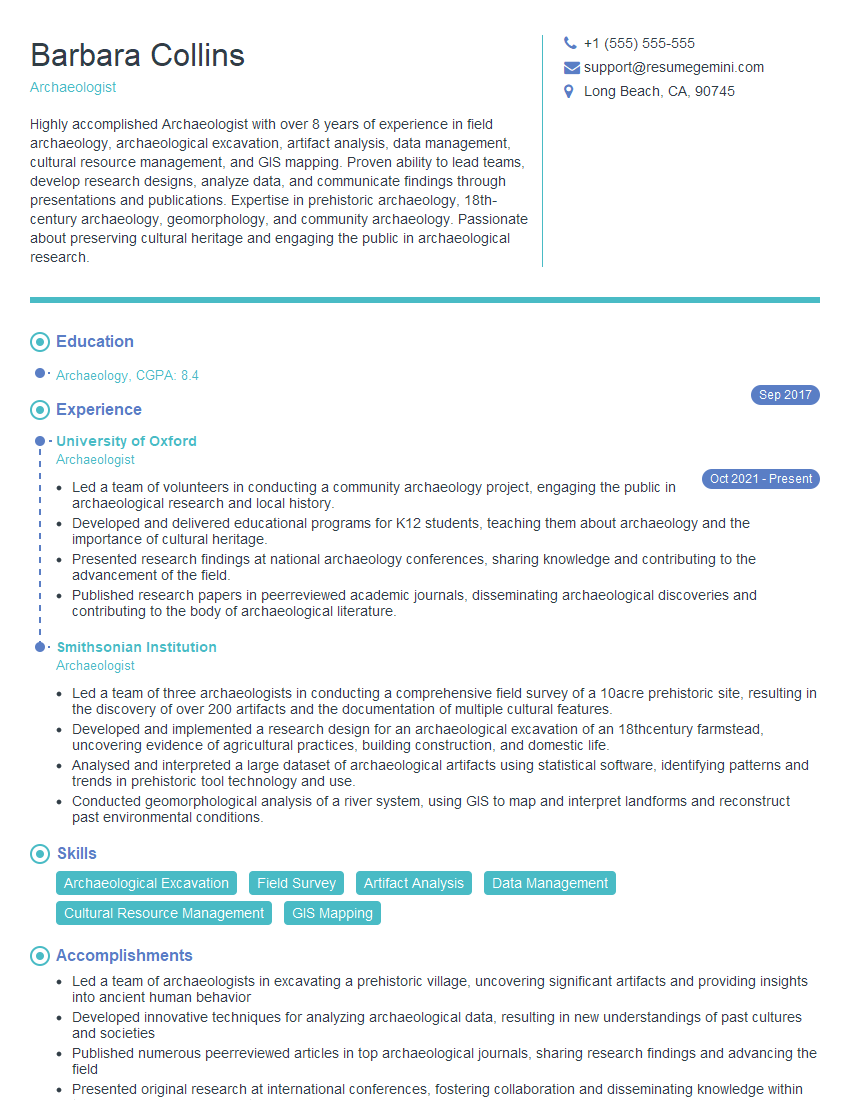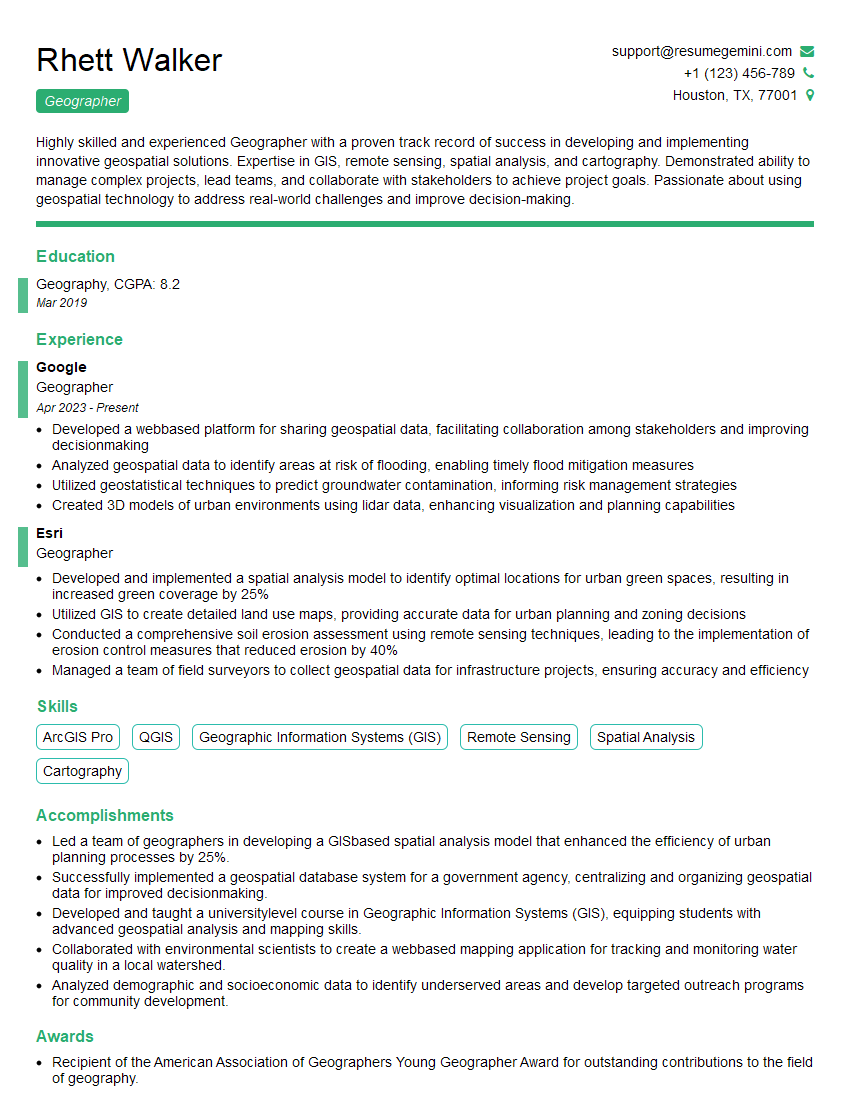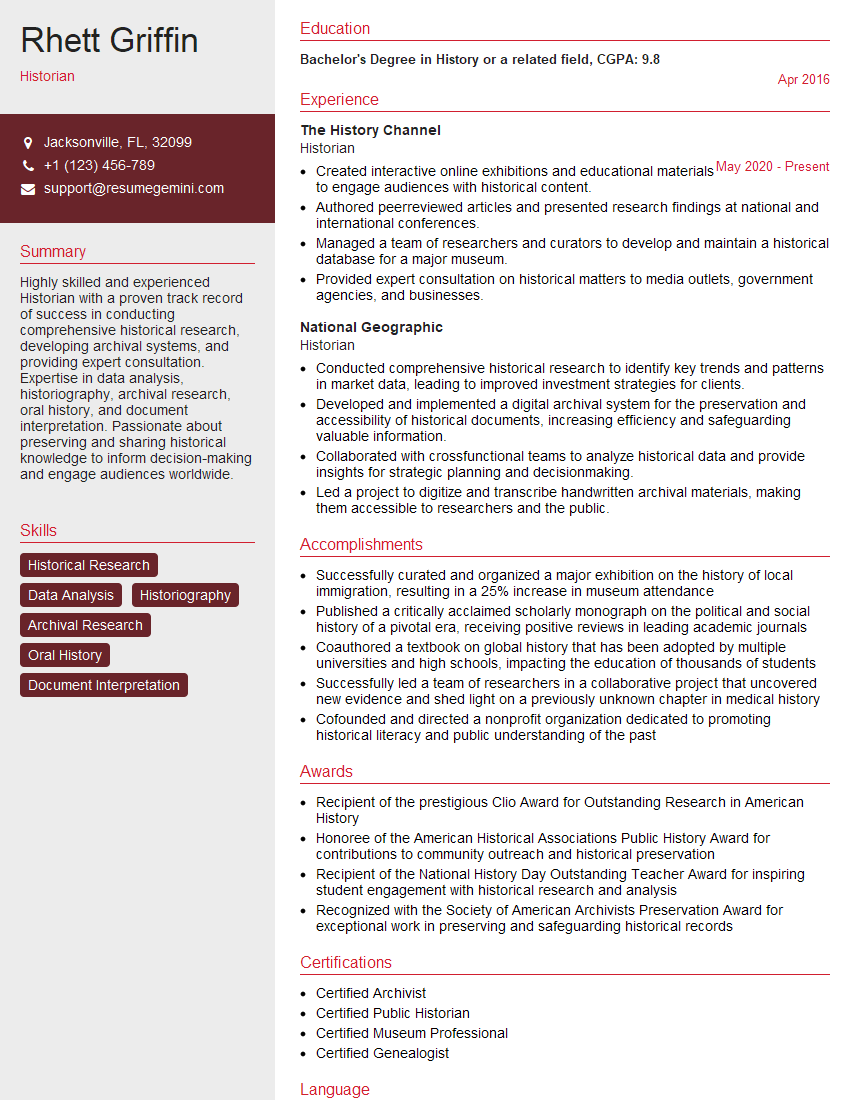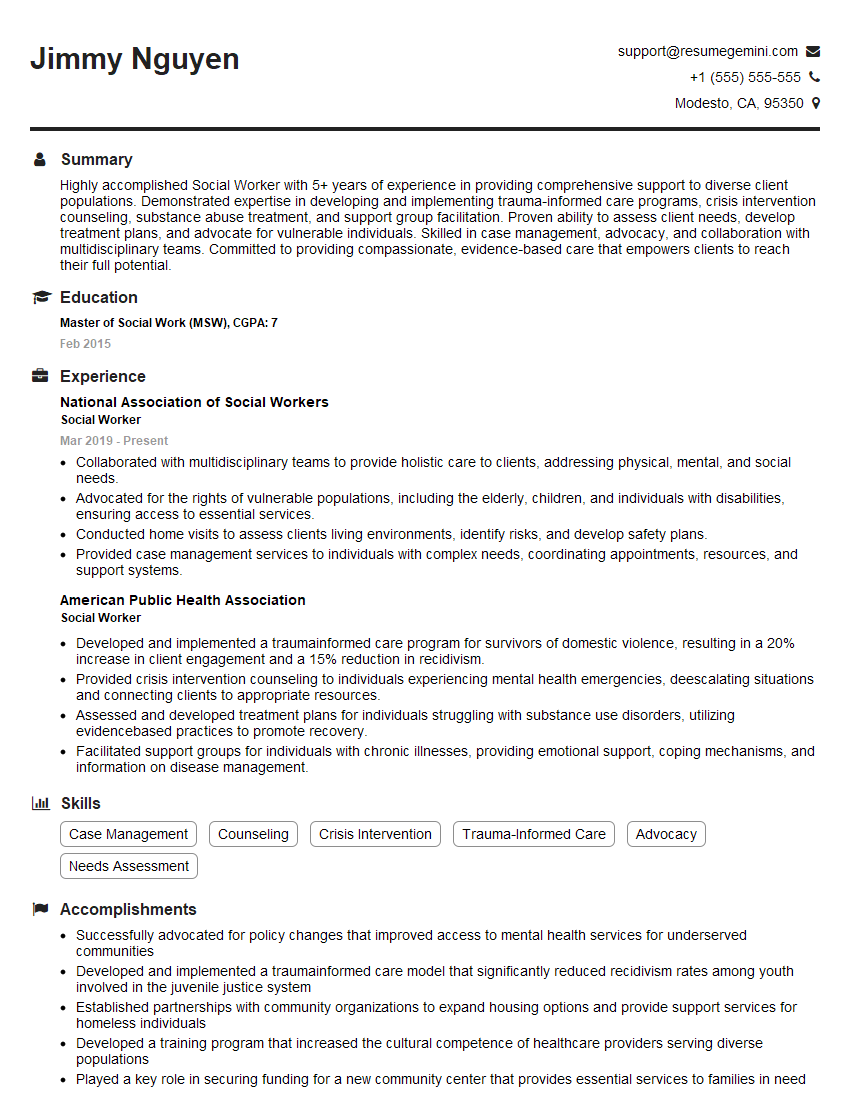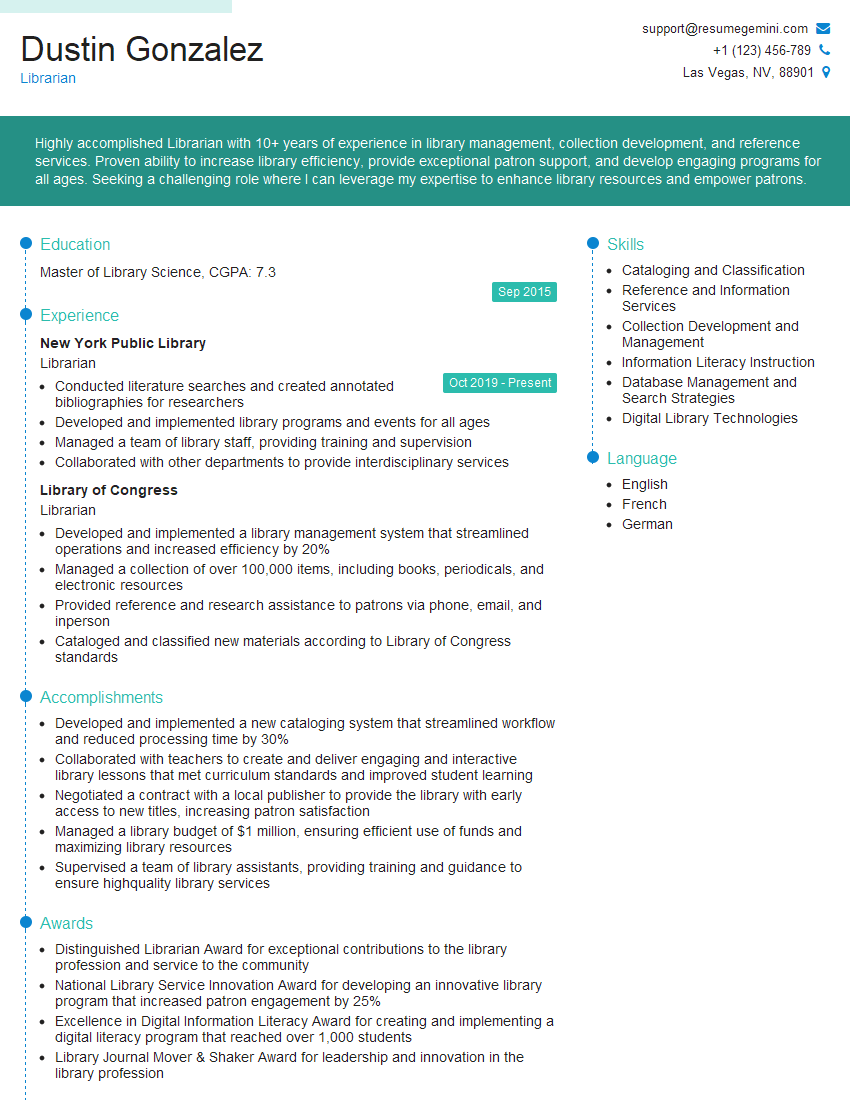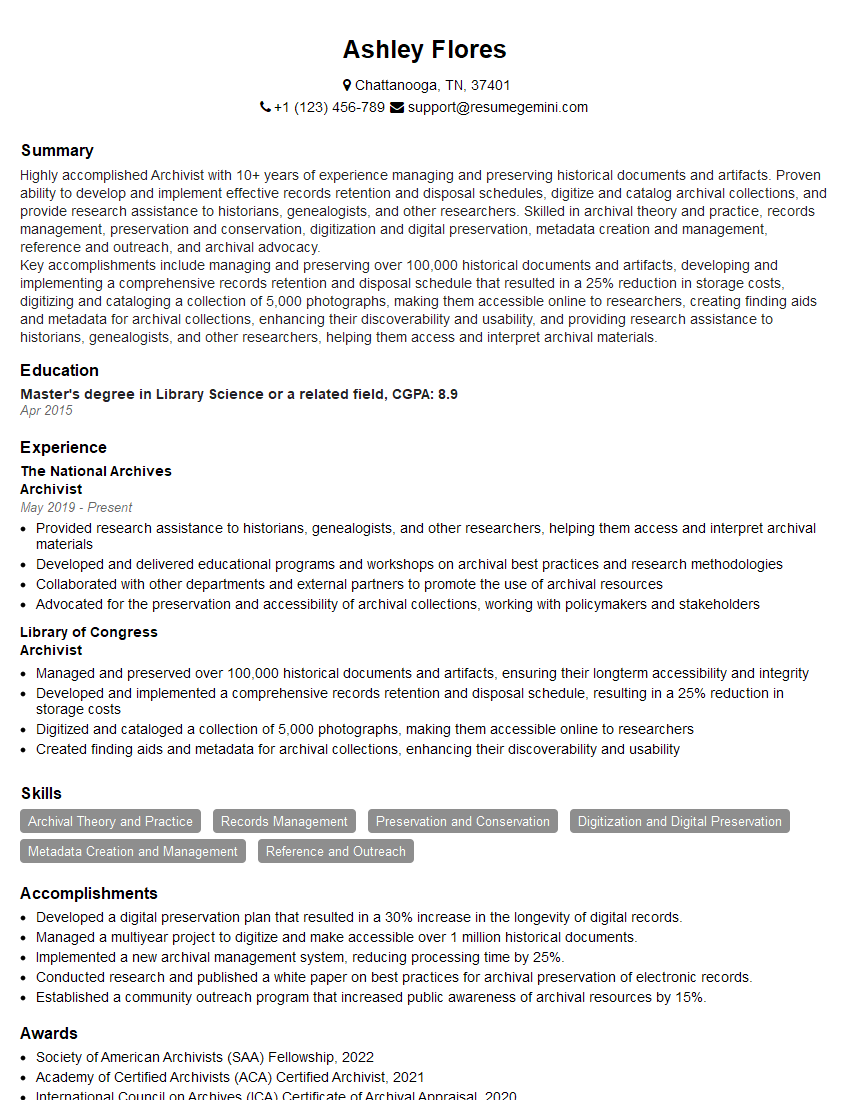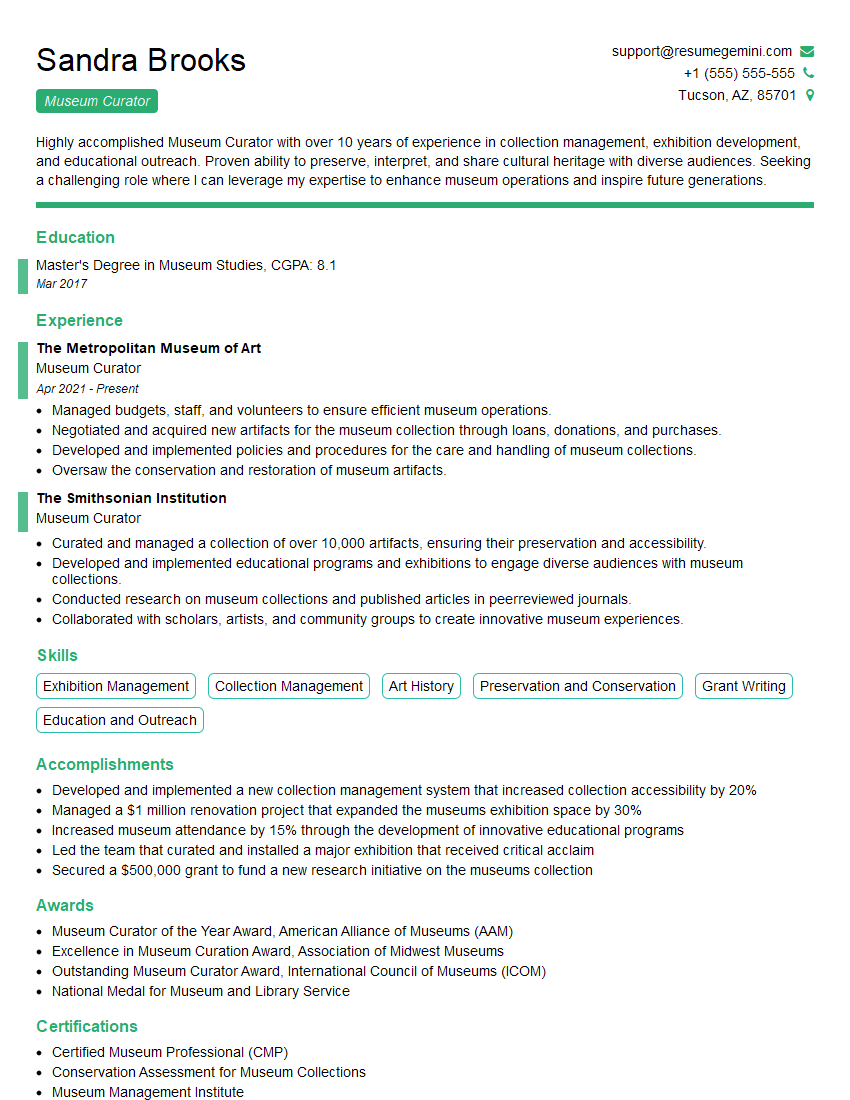Interviews are more than just a Q&A session—they’re a chance to prove your worth. This blog dives into essential Social Sciences and Humanities interview questions and expert tips to help you align your answers with what hiring managers are looking for. Start preparing to shine!
Questions Asked in Social Sciences and Humanities Interview
Q 1. Explain the difference between qualitative and quantitative research methods.
Qualitative and quantitative research methods represent two distinct approaches to understanding the social world. Qualitative research focuses on in-depth understanding of experiences, perspectives, and meanings. It emphasizes rich descriptive data gathered through methods like interviews, focus groups, and ethnography. The goal is to explore complex social phenomena and generate hypotheses rather than test them statistically.
Quantitative research, on the other hand, prioritizes numerical data and statistical analysis. It aims to measure and quantify variables, test hypotheses, and establish relationships between them. Common methods include surveys, experiments, and statistical modeling. The focus is on generalizability and establishing patterns across large populations.
- Qualitative Example: Conducting in-depth interviews with refugees to understand their experiences of resettlement.
- Quantitative Example: Surveying a large sample of voters to predict election outcomes.
The key difference lies in the type of data collected and the analytical techniques employed. While often presented as opposing approaches, they can be complementary, with qualitative research informing the design of quantitative studies, and quantitative findings providing context for qualitative interpretations.
Q 2. Describe a time you analyzed complex social data to draw meaningful conclusions.
During my research on the impact of social media on political polarization, I analyzed a large dataset of tweets containing political hashtags. This data was complex, encompassing millions of tweets with varied sentiment, language, and network connections. I began by cleaning the data, removing irrelevant tweets and handling missing values. Then, I used natural language processing techniques to analyze sentiment and identify key themes within the tweets. Network analysis allowed me to map the relationships between users and identify the spread of misinformation.
My analysis revealed a strong correlation between exposure to echo chambers on Twitter and increased political polarization. Users primarily interacting with like-minded individuals exhibited more extreme views and were less likely to engage in constructive dialogue. These findings were further supported by sentiment analysis, which showed a significant increase in negative sentiment towards opposing political viewpoints within these echo chambers. These conclusions contributed significantly to a published paper highlighting the urgent need for media literacy initiatives to combat online echo chambers.
Q 3. How would you approach researching a historical event using primary sources?
Researching a historical event using primary sources requires a methodical and critical approach. Primary sources – documents, artifacts, or testimonies created during the period under study – offer direct insight into the past, but require careful interpretation.
- Source Selection and Evaluation: Begin by identifying relevant primary sources. This may involve archival research, library visits, or online databases. Critically evaluate each source’s authenticity, authorship, and potential biases. Consider the context in which it was created – the author’s background, intended audience, and purpose.
- Data Collection and Organization: Systematically collect data from the chosen sources, taking detailed notes and recording relevant information. Organize your data using a method like a spreadsheet or a thematic framework to facilitate analysis.
- Interpretation and Analysis: Analyze the data by identifying patterns, trends, and contradictions. Compare and contrast different sources to build a comprehensive understanding. Consider multiple perspectives and avoid presentism – imposing modern values or interpretations on historical events.
- Synthesis and Conclusion: Synthesize your findings to construct a narrative that accurately reflects the historical event, highlighting key actors, events, and their interrelationships. Acknowledge limitations and uncertainties in your interpretation based on the available evidence.
For example, researching the American Civil War might involve analyzing letters from soldiers, government documents, and newspaper articles from the period, carefully considering the perspectives and biases inherent in each source to construct a balanced understanding of the conflict.
Q 4. What are some ethical considerations in conducting social science research?
Ethical considerations are paramount in social science research. Researchers have a responsibility to protect the rights and well-being of participants and maintain the integrity of their research.
- Informed Consent: Participants must be fully informed about the research purpose, procedures, risks, and benefits before agreeing to participate. They must be free to withdraw at any time without penalty.
- Confidentiality and Anonymity: Researcher must protect the privacy of participants by keeping their data confidential and anonymous whenever possible. Data should be securely stored and accessed only by authorized personnel.
- Avoidance of Harm: Researchers must take steps to minimize any potential physical, psychological, or social harm to participants. This includes considering the potential impact of the research on vulnerable populations.
- Data Integrity and Transparency: Researchers have a responsibility to ensure the accuracy and integrity of their data and to be transparent about their methods and findings. This includes avoiding fabrication, falsification, or plagiarism.
- Institutional Review Boards (IRBs): Many institutions have IRBs that review research proposals to ensure they adhere to ethical guidelines.
Failure to adhere to these ethical principles can have serious consequences, undermining the credibility of research and harming participants.
Q 5. Discuss the impact of globalization on a specific social issue.
Globalization’s impact on income inequality is a complex and multifaceted issue. While globalization has led to significant economic growth in many parts of the world, it has also exacerbated income inequality both within and between countries.
On one hand, globalization has facilitated the flow of capital and technology, leading to increased productivity and economic growth in many developing countries. However, this growth has not always been evenly distributed. Multinational corporations often locate their production facilities in countries with lower labor costs and weaker environmental regulations, leading to job losses in developed countries and exploitation of workers in developing countries.
Furthermore, globalization has increased competition for jobs, driving down wages for low-skilled workers in many countries. The benefits of globalization have often disproportionately accrued to highly skilled workers and capital owners, leading to a widening gap between the rich and the poor.
In conclusion, while globalization has contributed to overall economic growth, its impact on income inequality is undeniably complex and requires nuanced consideration of the various factors at play. Policies aimed at mitigating the negative impacts of globalization on income inequality, such as investments in education and training, social safety nets, and fair trade practices, are crucial for ensuring a more equitable distribution of the benefits of globalization.
Q 6. How does sociological theory inform your understanding of current events?
Sociological theories provide crucial frameworks for understanding current events. They offer lenses through which we can analyze social phenomena, identify underlying patterns, and predict potential outcomes.
For instance, conflict theory, which emphasizes power struggles and inequality as drivers of social change, helps illuminate current events like political polarization and social movements. Understanding the distribution of power and resources within society, as highlighted by conflict theory, is essential to comprehending the motivations and actions of different groups involved in these events.
Similarly, functionalist theory, which views society as a system with interdependent parts working together to maintain stability, can be applied to understand the challenges facing institutions like healthcare or education during a pandemic. Analyzing how these institutions adapt and respond to crises illustrates the functionalist perspective on social equilibrium.
By employing various sociological theories, we can move beyond superficial descriptions of current events and delve into the deeper social processes and structures that shape them, leading to more insightful and nuanced interpretations.
Q 7. Explain the concept of cultural relativism and its limitations.
Cultural relativism is the principle that a person’s beliefs, values, and practices should be understood based on that person’s own culture, rather than be judged against the criteria of another. It encourages empathy and avoids ethnocentrism (judging other cultures by the standards of one’s own).
For example, a practice considered taboo in one culture might be perfectly acceptable in another. Understanding this requires suspending judgment and seeking to understand the cultural context.
However, cultural relativism has limitations. Taken to an extreme, it can lead to moral relativism, making it difficult to condemn practices considered universally harmful, such as human rights violations. There’s a need to balance understanding cultural differences with upholding universal ethical principles. A nuanced approach is essential, acknowledging cultural diversity while maintaining a commitment to fundamental human rights and justice.
Q 8. Describe your understanding of a specific historical period and its significance.
The Enlightenment, spanning roughly from the late 17th to the late 18th century, holds immense significance in shaping modern Western thought and societal structures. It was a period characterized by a profound emphasis on reason, individualism, and human rights, challenging traditional authority and promoting intellectual and scientific inquiry.
Its significance lies in several key developments. Firstly, it saw the rise of influential thinkers like John Locke, Jean-Jacques Rousseau, and Immanuel Kant, who articulated groundbreaking ideas about natural rights, the social contract, and the separation of powers. These ideas directly influenced the American and French Revolutions, profoundly altering political landscapes globally.
Secondly, the Enlightenment spurred advancements in science and technology. The scientific method, emphasizing empirical observation and experimentation, gained prominence, leading to breakthroughs in various fields. This emphasis on reason and evidence challenged long-held religious and superstitious beliefs, fostering a more secular worldview.
Finally, the Enlightenment’s focus on human reason and individual liberty laid the groundwork for modern democratic ideals, including freedom of speech, religious tolerance, and the rule of law. While its legacy is complex and debated (e.g., its role in colonialism), its impact on shaping modern concepts of individual rights and governance is undeniable.
Q 9. How can economic principles be applied to understand social inequalities?
Economic principles, particularly those related to resource allocation, market dynamics, and wealth distribution, provide a powerful framework for understanding social inequalities. For instance, disparities in income and wealth can be analyzed through the lens of supply and demand, market imperfections (like monopolies or information asymmetry), and institutional factors (like discriminatory labor practices or unequal access to education).
The concept of human capital, which refers to the skills, knowledge, and experience that contribute to a person’s productivity, is crucial. Unequal access to quality education, healthcare, and other resources that build human capital directly leads to widening economic gaps. Think about the difference in earning potential between someone with a college degree and someone without; this gap often reflects systematic inequalities in access to higher education.
Furthermore, economic theories like the Gini coefficient, which measures income inequality, offer quantitative tools to assess and monitor the extent of social stratification. Policy interventions aimed at reducing inequality, such as progressive taxation, minimum wage laws, and social safety nets, are all informed by economic principles. Essentially, understanding the economic mechanisms that contribute to social disparities is critical for designing effective policies to address them.
Q 10. What are the key principles of effective communication in a professional setting?
Effective communication in a professional setting hinges on several key principles. Clarity is paramount; your message should be easily understood, avoiding jargon or overly complex language. Conciseness saves time and ensures your point is not lost amidst unnecessary details.
- Active Listening: Pay close attention, ask clarifying questions, and show genuine interest in what others have to say.
- Empathy: Consider the other person’s perspective and tailor your communication style to build rapport.
- Nonverbal Communication: Maintain appropriate eye contact, use positive body language, and be mindful of your tone of voice.
- Choosing the Right Medium: Select the most appropriate communication channel (email, phone call, meeting) for the message and context.
- Feedback: Encourage and solicit feedback to ensure mutual understanding and address any misunderstandings.
For example, instead of sending a long email explaining a complex issue, consider scheduling a brief meeting to discuss it directly, allowing for immediate clarification and feedback. This approach demonstrates respect for the recipient’s time and fosters a more productive interaction.
Q 11. Explain your understanding of a specific psychological theory and its applications.
Attachment theory, developed by John Bowlby and Mary Ainsworth, explores the lasting impact of early childhood relationships on adult behavior and mental health. It posits that the bond between a child and primary caregiver shapes the child’s internal working model of relationships – their expectations and beliefs about themselves and others.
There are several attachment styles identified, including secure, anxious-preoccupied, dismissive-avoidant, and fearful-avoidant. For example, individuals with a secure attachment style generally exhibit trust, intimacy, and autonomy in their relationships, whereas those with an anxious-preoccupied style may experience high anxiety and a fear of abandonment.
Applications of attachment theory are widespread. In therapy, it helps understand relationship difficulties, anxiety, and depression, guiding interventions to promote healthier relationship patterns. In parenting, it emphasizes the importance of sensitive and responsive caregiving to foster secure attachment. In organizational psychology, it informs team dynamics and leadership styles, highlighting the significance of trust and emotional safety within workplaces.
Q 12. Describe your experience working with diverse populations or communities.
My experience working with diverse populations has been extensive. For example, during a research project on immigrant integration, I conducted interviews with individuals from various cultural backgrounds, each with unique experiences and perspectives. This required me to be highly sensitive to cultural nuances, adapt my communication style, and utilize appropriate research methods to collect and analyze data in an ethical and respectful manner.
Another instance involved facilitating workshops for a community organization serving underprivileged youth. This required understanding the challenges they face and tailoring the workshops to be inclusive and relevant to their lives. It also involved adapting my facilitation style to promote active participation from individuals with varying levels of comfort in group settings.
These experiences have honed my cultural competency skills, emphasizing the importance of active listening, empathy, and cultural sensitivity in all interactions. I’ve learned to be adaptable and receptive to different communication styles and perspectives, making me a more effective collaborator and researcher.
Q 13. How do you approach conflict resolution in a team environment?
My approach to conflict resolution in a team setting emphasizes collaborative problem-solving and maintaining respectful communication. I start by actively listening to all parties involved, ensuring everyone feels heard and understood. It’s crucial to identify the root cause of the conflict, not just the surface-level symptoms.
Next, I facilitate a structured discussion, encouraging open communication and focusing on finding common ground. I often employ techniques like brainstorming solutions together, encouraging compromise, and exploring various perspectives. The goal is not to find a ‘winner’ but to find a mutually acceptable solution that addresses everyone’s concerns.
If necessary, I use mediation techniques to help facilitate communication and guide the discussion towards a resolution. I also prioritize maintaining a respectful and supportive environment, emphasizing empathy and understanding. Documentation of the process and agreement on the resolution is crucial for transparency and accountability.
Q 14. Discuss your experience using statistical software for data analysis (e.g., SPSS, R).
I have extensive experience using SPSS for data analysis in my research. I’m proficient in various statistical techniques, including descriptive statistics (mean, standard deviation, frequency distributions), correlation analysis, t-tests, ANOVA, and regression analysis. I can also conduct more advanced analyses like factor analysis and structural equation modeling.
For example, in a recent study analyzing the relationship between social media usage and self-esteem, I used SPSS to conduct correlation analyses to assess the strength and direction of the relationship between the variables. I then used regression analysis to control for potential confounding factors and determine the unique contribution of social media usage to self-esteem.
#Example SPSS Syntax for a simple t-test T-TEST GROUPS=group(1,2) /VARIABLES=variable /MISSING=ANALYSIS.
My skills extend beyond SPSS; I am also familiar with R and its various packages. R provides greater flexibility for data manipulation and visualization, particularly for complex datasets and custom analyses. I regularly utilize R for data cleaning, creating informative graphs, and executing specialized statistical models.
Q 15. Explain a time you had to adapt your research methodology due to unexpected challenges.
During my research on the impact of social media on political polarization, I initially planned to use a quantitative methodology, relying solely on analyzing large datasets of social media posts. However, I quickly realized that the inherent biases in the data – the algorithms shaping what users see, the self-selection bias of users participating in online discussions – were significantly affecting my results. My initial quantitative approach lacked the necessary depth to fully understand the nuanced human interactions driving polarization.
To address this, I adapted my methodology to incorporate qualitative methods. I conducted semi-structured interviews with individuals from diverse political backgrounds, allowing for a richer understanding of their online experiences and the factors shaping their views. This mixed-methods approach, combining quantitative data analysis with qualitative insights from interviews, provided a more robust and nuanced picture of the issue, mitigating the limitations of solely relying on quantitative data.
Career Expert Tips:
- Ace those interviews! Prepare effectively by reviewing the Top 50 Most Common Interview Questions on ResumeGemini.
- Navigate your job search with confidence! Explore a wide range of Career Tips on ResumeGemini. Learn about common challenges and recommendations to overcome them.
- Craft the perfect resume! Master the Art of Resume Writing with ResumeGemini’s guide. Showcase your unique qualifications and achievements effectively.
- Don’t miss out on holiday savings! Build your dream resume with ResumeGemini’s ATS optimized templates.
Q 16. How would you evaluate the credibility of information sources?
Evaluating the credibility of information sources in the social sciences and humanities requires a multi-faceted approach. It’s not just about identifying the source but also understanding its context and potential biases. I typically consider the following factors:
- Authority: Who authored the information? What are their credentials and expertise? Are they recognized experts in the field? Are there potential conflicts of interest?
- Accuracy: Is the information supported by evidence? Are sources cited? Does the information align with established knowledge in the field? Has it been peer-reviewed (if applicable)?
- Objectivity: Does the source present information in a balanced and unbiased manner, or is it presenting a particular viewpoint? Is the language neutral or emotionally charged?
- Currency: How recent is the information? Is it still relevant given the evolving nature of social and historical contexts? Older sources can be valuable but require careful consideration of their limitations.
- Purpose: What is the intended purpose of the source? Is it trying to inform, persuade, or entertain? Understanding the purpose helps assess potential biases and limitations.
For example, when researching historical events, I might cross-reference information from multiple primary sources (original documents, letters, etc.) with secondary sources (scholarly books and articles) to ensure a comprehensive and accurate understanding, acknowledging any potential biases present in each source.
Q 17. Describe your understanding of the scientific method in the context of social sciences.
The scientific method in the social sciences shares similarities with the natural sciences, but it adapts to the unique challenges of studying human behavior and society. It’s less about controlled experiments and more about systematic observation, interpretation, and explanation.
Typically, it involves:
- Formulating a research question: Identifying a specific aspect of human behavior or social phenomena to investigate.
- Developing a hypothesis: Formulating a testable statement about the relationship between variables.
- Gathering data: Employing appropriate research methods (surveys, interviews, experiments, historical analysis, etc.) to collect relevant data.
- Analyzing data: Using statistical or qualitative techniques to analyze the collected data and identify patterns or relationships.
- Drawing conclusions: Interpreting the findings in relation to the hypothesis and research question. This may lead to revisions of the hypothesis or further research.
- Disseminating findings: Sharing the research results through publications, presentations, or other forms of communication.
Unlike in the natural sciences, perfect control and replication are often unattainable due to the complexity of human behavior. Social scientists often use statistical methods to account for various factors that influence human behavior and draw more generalizable conclusions. The emphasis is on establishing rigorous methodologies to minimize bias and increase the reliability and validity of the findings.
Q 18. How can historical trends inform current policy decisions?
Historical trends provide invaluable context for current policy decisions by illuminating long-term patterns and consequences of specific actions or societal developments. Studying past successes and failures helps policymakers avoid repeating past mistakes and adapt policies more effectively.
For example, understanding historical trends in income inequality can inform policies aimed at reducing inequality today. Analyzing past economic policies and their effects on different social groups allows for a more informed approach to designing equitable and effective economic strategies. Similarly, studying historical patterns of migration can inform immigration policies, providing insights into potential challenges and opportunities associated with large-scale population movements.
Ignoring historical trends risks repeating past errors. A thorough analysis of history allows for a more nuanced understanding of the complex interplay of social, economic, and political factors that influence contemporary issues. It helps policymakers make evidence-based decisions that are more likely to achieve their intended outcomes.
Q 19. Discuss the importance of critical thinking in your field of study.
Critical thinking is paramount in the social sciences and humanities. It’s the foundation upon which rigorous research and informed analysis are built. It involves:
- Questioning assumptions: Examining the underlying assumptions behind arguments and claims, recognizing that what seems obvious might be a societal construct or biased perspective.
- Identifying biases: Recognizing and critically evaluating the influence of personal beliefs, cultural values, and societal pressures on interpretations and conclusions.
- Evaluating evidence: Carefully assessing the quality, relevance, and validity of evidence used to support claims, considering potential flaws or limitations in data collection and analysis.
- Considering alternative perspectives: Recognizing that complex social issues have multiple facets and perspectives. It necessitates engaging with diverse viewpoints and assessing the validity of each.
- Formulating well-reasoned arguments: Constructing coherent arguments supported by evidence and logical reasoning, acknowledging limitations and counterarguments.
Without critical thinking, we risk accepting flawed information, perpetuating biases, and formulating ineffective policies. The ability to think critically is crucial for producing meaningful research and contributing to a better understanding of the complexities of the human experience.
Q 20. Explain a time you had to synthesize information from multiple sources.
In a project examining the evolution of feminist thought, I had to synthesize information from a vast array of sources: primary texts from early feminist thinkers, secondary scholarly interpretations, historical documents, and contemporary feminist writings. This required a systematic approach.
My process involved:
- Identifying key themes and concepts: I first identified overarching themes across the diverse sources, such as concepts of gender equality, women’s rights, and social justice.
- Analyzing individual sources: I carefully read and analyzed each source, identifying key arguments, evidence, and perspectives. I noted any limitations or biases in each source.
- Comparing and contrasting different perspectives: I then compared and contrasted the arguments and perspectives presented across different sources, highlighting areas of agreement and disagreement.
- Identifying patterns and trends: Based on the comparison, I identified patterns and trends in the evolution of feminist thought, mapping how these concepts have changed over time.
- Synthesizing a coherent narrative: Finally, I synthesized the information into a coherent narrative that integrated the different perspectives and identified key milestones in the development of feminist ideas.
The outcome was a comprehensive overview of the evolution of feminist thought, highlighting the diverse perspectives and the ongoing debates within the movement. The process emphasized careful interpretation, acknowledging the limitations of each source while building a nuanced understanding of the overall subject matter.
Q 21. What are some limitations of your chosen field of study?
While the social sciences and humanities offer invaluable insights into human behavior and society, several limitations exist:
- Subjectivity and Bias: The very nature of studying human behavior introduces subjectivity. Researchers’ biases, both conscious and unconscious, can influence research design, data interpretation, and conclusions.
- Difficulty in Establishing Causality: It’s often challenging to establish clear cause-and-effect relationships in complex social phenomena. Multiple factors usually interact, making it difficult to isolate the impact of a single variable.
- Ethical Considerations: Research involving human subjects raises ethical concerns about privacy, informed consent, and potential harm. Researchers must adhere to strict ethical guidelines to protect participants.
- Generalizability of Findings: Findings from a specific study may not always be generalizable to other populations or contexts. The results may be influenced by factors specific to the studied group or environment.
- Limited Predictive Power: While social science research can help us understand past and present trends, its ability to predict future outcomes is limited due to the complexity and ever-changing nature of human societies.
Acknowledging these limitations is crucial for responsible and ethical research practice. Social scientists must strive to minimize bias, carefully consider the context of their findings, and communicate the limitations of their research transparently.
Q 22. How would you apply your skills and knowledge to address a real-world problem?
My skills and knowledge in social sciences and humanities are best applied to address real-world problems by framing them within a robust theoretical understanding and employing rigorous research methodologies. For example, consider the rising issue of misinformation and its impact on public health. I wouldn’t simply treat it as a technological problem, but rather as a complex social phenomenon rooted in historical patterns of communication, evolving media landscapes, and socio-economic inequalities.
My approach would involve:
- Literature Review: Analyzing existing research on misinformation, propaganda, and public health campaigns to understand the mechanisms of spread and their effectiveness.
- Qualitative Research: Conducting interviews and focus groups to understand how individuals perceive and interact with information, identifying vulnerabilities to misinformation.
- Quantitative Research: Utilizing surveys and statistical analysis to measure the prevalence of misinformation and its impact on behavior, such as vaccine hesitancy.
- Intervention Design: Based on the research findings, developing and testing interventions – perhaps using narrative persuasion techniques or community-based education programs – aimed at fostering critical thinking and media literacy.
The goal is to develop evidence-based strategies, not just identify problems. This multi-faceted approach, drawing on diverse methodologies and theoretical frameworks, is crucial for tackling multifaceted societal challenges.
Q 23. Describe your experience conducting literature reviews.
Conducting literature reviews is fundamental to my research process. It’s not just about summarizing existing work; it’s about critically synthesizing information to identify gaps, refine research questions, and build a robust theoretical foundation. My approach involves:
- Defining Scope: Clearly outlining the research question and identifying relevant keywords and databases (e.g., JSTOR, Scopus, Web of Science).
- Systematic Searching: Employing a systematic search strategy to minimize bias and ensure comprehensive coverage, often using Boolean operators (
AND,OR,NOT) to refine searches. - Critical Appraisal: Evaluating the quality and relevance of each source, considering its methodology, sample size, and potential limitations. This involves assessing the credibility of the author and publication.
- Synthesis and Analysis: Organizing and synthesizing information to identify key themes, debates, and gaps in the existing literature. This often involves creating thematic maps or concept maps to visualize relationships.
- Writing the Review: Clearly articulating the findings of the literature review, highlighting key themes and debates, and identifying areas needing further research. The writing should be concise, well-structured, and accessible to a broad audience.
For instance, in a project on the impact of social media on political polarization, I meticulously reviewed studies using both quantitative (e.g., network analysis) and qualitative methods (e.g., content analysis of social media posts), synthesizing findings to build a nuanced understanding of the phenomenon.
Q 24. Explain your understanding of a specific theoretical framework in your field.
One theoretical framework I frequently utilize is Social Cognitive Theory (SCT). SCT, developed by Albert Bandura, posits that human behavior is shaped by a complex interplay of personal factors (e.g., beliefs, self-efficacy), environmental factors (e.g., social norms, opportunities), and behavioral factors (e.g., skills, actions). It moves beyond simple stimulus-response models, recognizing the active role individuals play in shaping their own behavior and their environments.
SCT’s strength lies in its applicability to various social issues. For example, in public health research, it can be used to understand health behaviors (e.g., smoking, exercise) by examining the interplay of individual beliefs (e.g., perceived susceptibility to disease), social norms (e.g., peer pressure), and environmental influences (e.g., access to healthy food). Intervention strategies can then be tailored to target specific factors within this framework. For instance, a campaign to increase physical activity might focus on boosting self-efficacy through skills training and providing access to exercise facilities.
Critically, SCT recognizes the reciprocal determinism – the continuous interaction between personal, environmental, and behavioral factors. This dynamic interaction is essential for understanding the complexity of human behavior and designing effective interventions.
Q 25. How can you contribute to a more inclusive and equitable society?
Contributing to a more inclusive and equitable society requires a multi-pronged approach grounded in social justice principles and evidence-based research. My contribution involves:
- Researching Inequalities: Conducting research to identify and analyze systemic inequalities, examining their root causes and consequences across various social dimensions (e.g., race, gender, class, sexual orientation).
- Advocating for Marginalized Groups: Using my research findings to advocate for policies and practices that promote equity and social justice. This might involve working with community organizations or policymakers to address issues of discrimination and marginalization.
- Promoting Diversity and Inclusion: In my professional roles, I actively promote diversity and inclusion by advocating for equitable representation in research teams and fostering an inclusive research environment. I’m committed to employing culturally sensitive research methods.
- Education and Awareness: Through teaching, public speaking, and writing, I aim to raise awareness about social inequalities and empower others to actively work towards a more equitable society.
For instance, I’ve worked on projects examining the gender pay gap, focusing on both quantitative analysis of wage data and qualitative exploration of women’s experiences in the workplace. This research informed policy recommendations aimed at reducing the gap and fostering greater workplace equity.
Q 26. What is your understanding of the role of technology in social science research?
Technology plays a transformative role in social science research, offering both opportunities and challenges. On the one hand, it expands the scope and scale of research, enabling the collection and analysis of large datasets, the use of innovative methodologies (e.g., digital ethnography), and the dissemination of findings to wider audiences.
Examples include:
- Big Data Analysis: Utilizing computational methods to analyze large-scale social media data or government datasets to identify patterns and trends in social behavior.
- Online Surveys and Experiments: Conducting large-scale online surveys and experiments to collect data efficiently and reach diverse populations.
- Geographic Information Systems (GIS): Mapping social phenomena (e.g., crime rates, poverty levels) to visualize spatial patterns and relationships.
- Digital Ethnography: Conducting research within online communities to understand social interactions and cultural practices.
However, it’s crucial to be mindful of the ethical implications, including data privacy, algorithmic bias, and the potential for digital divides to exacerbate existing inequalities. Researchers must adhere to strict ethical guidelines to ensure responsible and equitable use of technology in social science research.
Q 27. Describe a project where you successfully used your research skills to achieve a goal.
In a recent project, I used my research skills to examine the effectiveness of a community-based intervention program aimed at reducing youth violence. The goal was to assess the program’s impact and identify areas for improvement. My approach was multi-faceted:
- Data Collection: We collected data using a mixed-methods approach, including pre- and post-intervention surveys to measure changes in attitudes and behaviors, interviews with program participants and staff, and observation of program activities.
- Data Analysis: Quantitative data (survey responses) were analyzed using statistical methods (e.g., t-tests, ANOVA) to assess statistically significant changes. Qualitative data (interview transcripts, observations) were analyzed thematically to identify key themes and patterns.
- Impact Assessment: The findings indicated a statistically significant reduction in reported violent incidents among program participants. The qualitative data provided rich insights into the mechanisms through which the program was effective, highlighting the importance of building trust and fostering positive relationships within the community.
- Recommendations: Based on these findings, we provided recommendations for improving the program’s design and implementation. For example, we suggested expanding the program’s reach and strengthening its community partnerships. The results were shared with policymakers, program administrators, and community stakeholders to inform future initiatives.
This project demonstrates my ability to utilize diverse research methods, analyze complex data, and translate research findings into actionable recommendations to solve a real-world problem.
Key Topics to Learn for Social Sciences and Humanities Interviews
- Sociological Theories: Understand foundational theories like functionalism, conflict theory, and symbolic interactionism, and their application to contemporary social issues. Consider how these theories inform research methodologies.
- Research Methods: Familiarize yourself with qualitative and quantitative research methods, including data collection techniques, analysis, and ethical considerations. Be prepared to discuss your experience with specific methods.
- Historical Analysis: Develop your ability to critically analyze historical events and trends, considering diverse perspectives and interpretations. Practice explaining cause-and-effect relationships and identifying biases.
- Cultural Studies: Demonstrate understanding of cultural production, consumption, and representation. Be ready to discuss the role of media, power dynamics, and identity formation.
- Political Science Concepts: Grasp core political concepts such as power, governance, ideology, and political systems. Be prepared to discuss current political events through a theoretical lens.
- Problem-Solving & Critical Thinking: Practice applying your knowledge to real-world problems. Develop the ability to analyze complex situations, identify potential solutions, and articulate your reasoning clearly and concisely.
- Communication Skills: Refine your ability to articulate complex ideas clearly and persuasively, both orally and in writing. Prepare for both structured and unstructured interview formats.
Next Steps
Mastering the Social Sciences and Humanities opens doors to a diverse range of rewarding careers, offering opportunities for impactful research, insightful analysis, and meaningful contributions to society. To maximize your job prospects, a strong, ATS-friendly resume is crucial. ResumeGemini can help you craft a compelling resume that showcases your skills and experience effectively. ResumeGemini offers examples of resumes tailored specifically to Social Sciences and Humanities professionals, ensuring your application stands out. Invest the time to create a professional, well-structured resume – it’s a vital step in your career journey.
Explore more articles
Users Rating of Our Blogs
Share Your Experience
We value your feedback! Please rate our content and share your thoughts (optional).
What Readers Say About Our Blog
Interesting Article, I liked the depth of knowledge you’ve shared.
Helpful, thanks for sharing.
Hi, I represent a social media marketing agency and liked your blog
Hi, I represent an SEO company that specialises in getting you AI citations and higher rankings on Google. I’d like to offer you a 100% free SEO audit for your website. Would you be interested?

